Related Research Articles
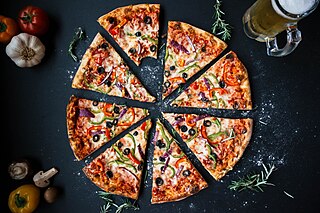
Pizza is a traditional Italian dish typically consisting of a flat base of leavened wheat-based dough topped with tomato, cheese, and other ingredients, baked at a high temperature, traditionally in a wood-fired oven.

Pastry is baked food made with a dough of flour, water, and shortening that may be savoury or sweetened. Sweetened pastries are often described as bakers' confectionery. The word "pastries" suggests many kinds of baked products made from ingredients such as flour, sugar, milk, butter, shortening, baking powder, and eggs. Small tarts and other sweet baked products are called pastries as a synecdoche. Common pastry dishes include pies, tarts, quiches, croissants, and pasties.

A bagel is a bread roll originating in the Jewish communities of Poland. Bagels are traditionally made from yeasted wheat dough that is shaped by hand into a torus or ring, briefly boiled in water, and then baked. The result is a dense, chewy, doughy interior with a browned and sometimes crisp exterior.

A baker is a tradesperson who bakes and sometimes sells breads and other products made of flour by using an oven or other concentrated heat source. The place where a baker works is called a bakery.

A baguette is a long, thin type of bread of French origin that is commonly made from basic lean dough. It is distinguishable by its length and crisp crust.

Calzone is an Italian oven-baked turnover, made with leavened dough. It originated in Naples in the 18th century. A typical calzone is made from salted bread dough, baked in an oven and stuffed with salami, ham or vegetables, mozzarella, ricotta and Parmesan or pecorino cheese, as well as an egg. Different regional variations in or on a calzone can often include other ingredients that are normally associated with pizza toppings. The term usually applies to an oven-baked turnover rather than a fried pastry, though calzoni and panzerotti are often mistaken for each other.
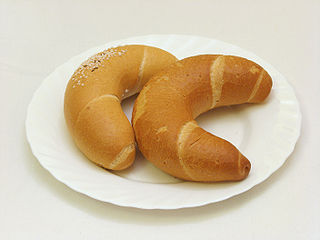
Kifli, kiflice, kifle, or kipferl is a traditional yeast bread roll that is rolled and formed into a crescent before baking.
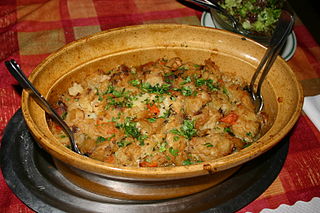
Baeckeoffe is a casserole dish that is typical in the French region of Alsace, situated on the border with Germany.

Lángos is a typical Hungarian food. Nowadays it is a deep fried flatbread, but in the past it was made of the last bits of the bread-dough and baked at the front of a brick or clay oven, to be served hot as the breakfast of the bread-baking day.
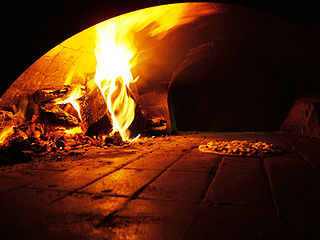
A masonry oven, colloquially known as a brick oven or stone oven, is an oven consisting of a baking chamber made of fireproof brick, concrete, stone, clay, or cob. Though traditionally wood-fired, coal-fired ovens were common in the 19th century, and modern masonry ovens are often fired with natural gas or even electricity. Modern masonry ovens are closely associated with artisan bread and pizza, but in the past they were used for any cooking task involving baking. Masonry ovens are built by masons.
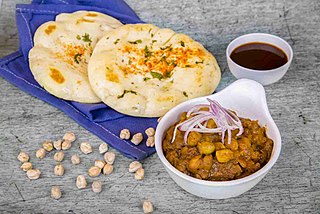
Kulcha is a Persian term for a disc-shaped loaf of leavened bread. In India, this term is commonly used for regular English bread.

In cooking, proofing is a step in the preparation of yeast bread and other baked goods in which the dough is allowed to rest and rise a final time before baking. During this rest period, yeast ferments the dough and produces gases, thereby leavening the dough.

The cuisine of Sardinia is the traditional cuisine of the island of Sardinia, and the expression of its culinary art. It is characterised by its own variety, and by the fact of having been enriched through a number of interactions with the other Mediterranean cultures while retaining its own identity. Sardinia's food culture is strictly divided into food from the land and food from the sea, reflecting the island's historical vicissitudes and especially its geographic landscapes, spacing from the coastline to the ragged mountains of the interior. The Sardinian cuisine is considered part of the Mediterranean diet, a nutritional model that was proclaimed by UNESCO as an intangible cultural heritage.

Tandoor bread refers to a bread baked in a clay oven called a tandoor.

The gnocco fritto or crescentina is an Italian bread from the Emilia-Romagna region of Italy, prepared using flour, water and lard as primary ingredients. Cracklings are sometimes used in its preparation as well. In Emilia-Romagna, it is typically sliced into diamond shapes and then fried, and may be accompanied with cheese and salumi. When it is fried, the bread puffs up, and it may include yeast or baking soda to leaven it. Versions prepared with milk are softer than those prepared with water. It may be served either as an appetizer or as a main dish. Despite the name by which in Italy it is often referred to as a kind of gnocchi, it is technically not.

Bataw is a leavened flatbread from Egypt. It is widely consumed in the Egyptian countryside. The main ingredients of the bread vary depending on the region.
References
- 1 2 3 4 Mariani, John F (1999). Encyclopedia of American Food and Drink . Lebhar-Friedman Books. p. 4. ISBN 0-86730-784-6.
- 1 2 3 "In New Mexico, Bakers Keep the Tradition of Pueblo Bread Alive". Atlas Obscura. Retrieved 2024-05-16.
- 1 2 3 4 Herbst, Ron; Herbst, Sharon Tyler (2015). The Deluxe Food Lover's Companion. Sourcebooks. ISBN 9781438076218.
- ↑ Frank, Lois Ellen (February 20, 2013). Foods of the Southwest Indian Nations: Traditional and Contemporary Native American Recipes. Clarkson Potter/Ten Speed.
- ↑ Dent, Huntley (November 23, 1993). Feast of Santa Fe: Cooking of the American Southwest. Simon & Schuster. ISBN 9780671873028.